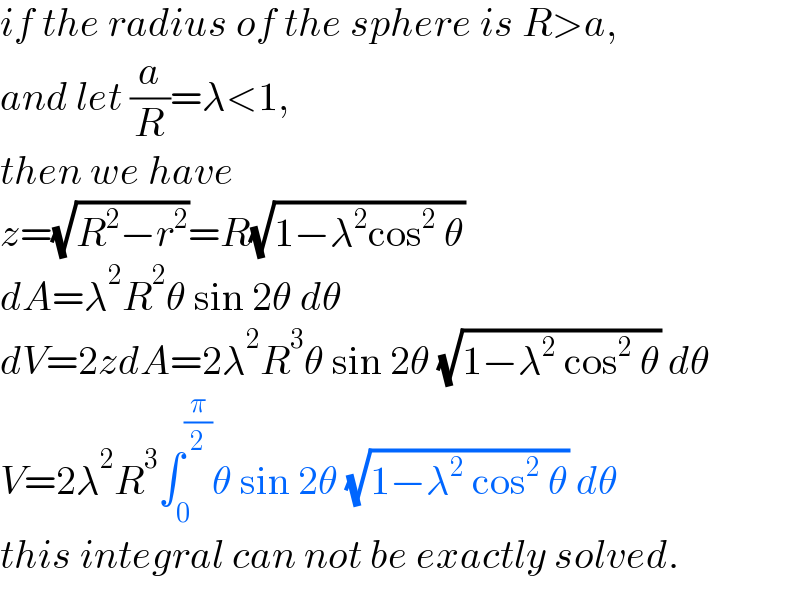
Question Number 183165 by universe last updated on 21/Dec/22

Answered by mr W last updated on 22/Dec/22

Commented by mr W last updated on 21/Dec/22

$${r}={a}\:\mathrm{cos}\:\theta \\ $$$${dr}=−{a}\:\mathrm{sin}\:\theta\:{d}\theta \\ $$$${dA}=−\mathrm{2}\theta{rdr}=\mathrm{2}{a}^{\mathrm{2}} \theta\:\mathrm{cos}\:\theta\:\mathrm{sin}\:\theta{d}\theta={a}^{\mathrm{2}} \theta\:\mathrm{sin}\:\mathrm{2}\theta\:{d}\theta \\ $$$${z}=\sqrt{{a}^{\mathrm{2}} −{r}^{\mathrm{2}} }=\sqrt{{a}^{\mathrm{2}} \left(\mathrm{1}−\mathrm{cos}^{\mathrm{2}} \:\theta\right)}={a}\:\mathrm{sin}\:\theta \\ $$$${dV}=\mathrm{2}{zdA}=\mathrm{2}{a}^{\mathrm{3}} \theta\:\mathrm{sin}\:\mathrm{2}\theta\:\mathrm{sin}\:\theta\:{d}\theta \\ $$$${V}=\mathrm{2}{a}^{\mathrm{3}} \int_{\mathrm{0}} ^{\frac{\pi}{\mathrm{2}}} \theta\:\mathrm{sin}\:\mathrm{2}\theta\:\mathrm{sin}\:\theta\:{d}\theta \\ $$$${V}=\mathrm{2}{a}^{\mathrm{3}} ×\frac{\mathrm{3}\pi−\mathrm{4}}{\mathrm{9}} \\ $$$$\Rightarrow{V}=\frac{\mathrm{2}\left(\mathrm{3}\pi−\mathrm{4}\right){a}^{\mathrm{3}} }{\mathrm{9}}\approx\mathrm{1}.\mathrm{2055}{a}^{\mathrm{3}} \\ $$
Commented by universe last updated on 22/Dec/22

$${thanks}\:{sir} \\ $$
Commented by mr W last updated on 22/Dec/22

$${if}\:{the}\:{radius}\:{of}\:{the}\:{sphere}\:{is}\:{R}>{a}, \\ $$$${and}\:{let}\:\frac{{a}}{{R}}=\lambda<\mathrm{1}, \\ $$$${then}\:{we}\:{have} \\ $$$${z}=\sqrt{{R}^{\mathrm{2}} −{r}^{\mathrm{2}} }={R}\sqrt{\mathrm{1}−\lambda^{\mathrm{2}} \mathrm{cos}^{\mathrm{2}} \:\theta} \\ $$$${dA}=\lambda^{\mathrm{2}} {R}^{\mathrm{2}} \theta\:\mathrm{sin}\:\mathrm{2}\theta\:{d}\theta \\ $$$${dV}=\mathrm{2}{zdA}=\mathrm{2}\lambda^{\mathrm{2}} {R}^{\mathrm{3}} \theta\:\mathrm{sin}\:\mathrm{2}\theta\:\sqrt{\mathrm{1}−\lambda^{\mathrm{2}} \:\mathrm{cos}^{\mathrm{2}} \:\theta}\:{d}\theta \\ $$$${V}=\mathrm{2}\lambda^{\mathrm{2}} {R}^{\mathrm{3}} \int_{\mathrm{0}} ^{\frac{\pi}{\mathrm{2}}} \theta\:\mathrm{sin}\:\mathrm{2}\theta\:\sqrt{\mathrm{1}−\lambda^{\mathrm{2}} \:\mathrm{cos}^{\mathrm{2}} \:\theta}\:{d}\theta \\ $$$${this}\:{integral}\:{can}\:{not}\:{be}\:{exactly}\:{solved}. \\ $$
